AM2 Motherboards-Part 4: ATI Crossfire Xpress 3200
by Wesley Fink on August 21, 2006 7:00 AM EST- Posted in
- Motherboards
General Performance
With the Memory Controller on the Athlon 64 Processor, Winstone benchmarks are no longer very revealing of motherboard performance. With the same CPU (and the same memory controller on that CPU) both Winstones are tightly clustered. The only deviation from that is that boards that are tweaked for best gaming performance are often near the bottom of a tight range of benchmark performance numbers. The Winstone tests themselves are rapidly becoming dated, and are no longer supported by PC Magazine. While Winstones are still useful in providing real world performance data in CPU testing, we have dropped Winstones from our standard motherboard test suite.
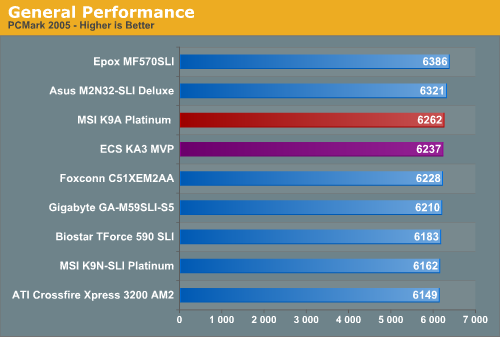
PCMark2005 results for the nine AM2 boards show the Epox 570SLI at the top of the performance chart, followed closely the ASUS M2N32-SLI and the MSI K9A Platinum. The ECS and Foxconn are next in PCM05 performance. These results for the MSI and ASUS are very much in line with other results, as both these boards consistently appear at or near the top of our performance testing.
PCMark05, together with 2 benchmarks that use rendering to test system performance - Cinebench 9.5 and POV-Ray 3.6 - have replaced Winstones for testing general performance. Cinebench 9.5 and POV-RAY 3.6 benchmarks both heavily stress the CPU subsystem while performing graphics modeling and rendering. We utilize the standard benchmark demos in each program along with the default settings. Cinebench 9.5 features two different benchmarks with one test utilizing a single core and the second test using the power of multiple cores to render the benchmark image.
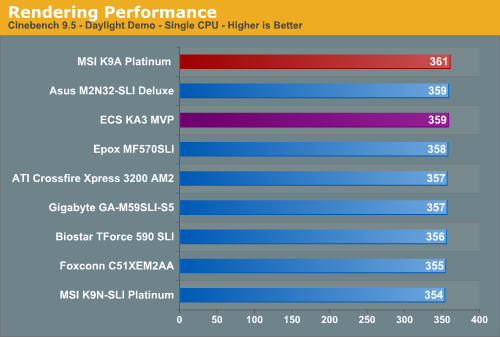
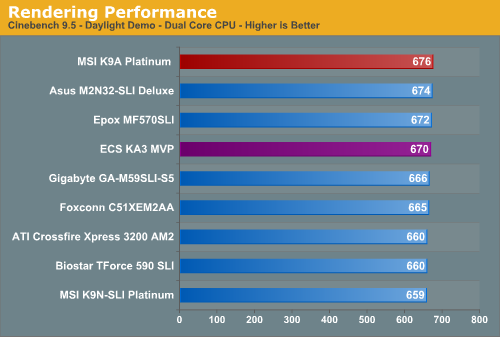
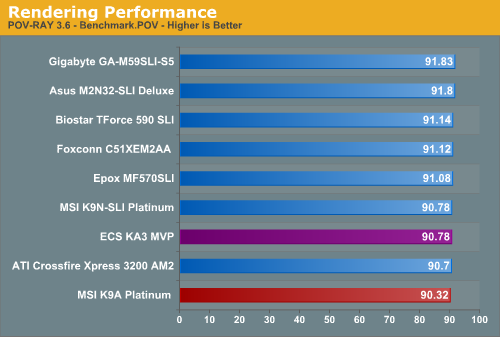
While results are generally close in Cinebench, the MSI K9A, based on the ATI Xpress 3200 chipset, tops both Single-Core and Dual-Core test results. The MSI RD580 is followed closely by the ASUS 590SLI, the ECS KA3 which is also based on the RD580, and the NVIDIA 570SLI based Epox MF570SLI. POV-Ray results are extremely close across DDR2 platforms and show the Gigabyte and ASUS to be the top performers. The ATI chipset boards are reversed in POV-Ray, with all 3 RD580 boards at the bottom of a tightly clustered performance pack.
3D Graphics
The 3DMark benchmarks, published by Futuremark, are probably the most widely quoted gaming performance benchmarks available. While the benchmarks are based on game sequences written by Futuremark to reveal subtle differences in gaming performance, they still have to be considered synthetic benchmarks. They are useful for broad Graphics comparisons, but they are no substitute for benchmarks with real gaming engines that are currently being played.
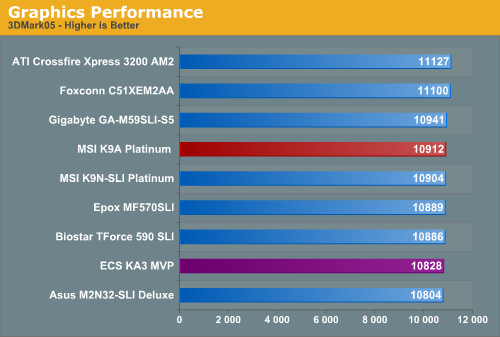
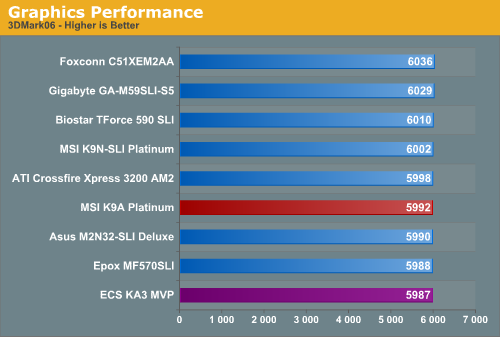
The MSI K9A managed to place in the top of 3DMark05 performance, while the ECS was one of the poorer performers in the AM2 test group. After topping PCMark2005 it was a surprise to see the MSI, ASUS, Epox, and ECS nailing down the bottom of 3DMark06 performance. Results were close, differences were minor, but neither the MSI nor ECS distinguished themselves in this newest 3DMark benchmark.
Encoding
We have found encoding results are not affected by the graphics card used during the encoding benchmarks, which should come as no surprise since theoretically this is to be expected. This is demonstrated again and again by archive test results for AutoGK using an AMD 4000+ processor with a wide assortment of video cards. The performance range of encoding tests over 2 years with the same CPU is just 48.1 to 49.1 - a difference form high to low of just 1.0 frame. Clearly the biggest influence on this encoding benchmark is the CPU used for testing. Because encoding test results vary so little on the same standardized motherboard test platform, they have been dropped from motherboard reviews. Encoding tests are very useful in CPU testing, but they have been shown to be poor motherboard tests - particularly on the AMD platforms with the memory controller on the CPU.
With the Memory Controller on the Athlon 64 Processor, Winstone benchmarks are no longer very revealing of motherboard performance. With the same CPU (and the same memory controller on that CPU) both Winstones are tightly clustered. The only deviation from that is that boards that are tweaked for best gaming performance are often near the bottom of a tight range of benchmark performance numbers. The Winstone tests themselves are rapidly becoming dated, and are no longer supported by PC Magazine. While Winstones are still useful in providing real world performance data in CPU testing, we have dropped Winstones from our standard motherboard test suite.

PCMark2005 results for the nine AM2 boards show the Epox 570SLI at the top of the performance chart, followed closely the ASUS M2N32-SLI and the MSI K9A Platinum. The ECS and Foxconn are next in PCM05 performance. These results for the MSI and ASUS are very much in line with other results, as both these boards consistently appear at or near the top of our performance testing.
PCMark05, together with 2 benchmarks that use rendering to test system performance - Cinebench 9.5 and POV-Ray 3.6 - have replaced Winstones for testing general performance. Cinebench 9.5 and POV-RAY 3.6 benchmarks both heavily stress the CPU subsystem while performing graphics modeling and rendering. We utilize the standard benchmark demos in each program along with the default settings. Cinebench 9.5 features two different benchmarks with one test utilizing a single core and the second test using the power of multiple cores to render the benchmark image.



While results are generally close in Cinebench, the MSI K9A, based on the ATI Xpress 3200 chipset, tops both Single-Core and Dual-Core test results. The MSI RD580 is followed closely by the ASUS 590SLI, the ECS KA3 which is also based on the RD580, and the NVIDIA 570SLI based Epox MF570SLI. POV-Ray results are extremely close across DDR2 platforms and show the Gigabyte and ASUS to be the top performers. The ATI chipset boards are reversed in POV-Ray, with all 3 RD580 boards at the bottom of a tightly clustered performance pack.
3D Graphics
The 3DMark benchmarks, published by Futuremark, are probably the most widely quoted gaming performance benchmarks available. While the benchmarks are based on game sequences written by Futuremark to reveal subtle differences in gaming performance, they still have to be considered synthetic benchmarks. They are useful for broad Graphics comparisons, but they are no substitute for benchmarks with real gaming engines that are currently being played.


The MSI K9A managed to place in the top of 3DMark05 performance, while the ECS was one of the poorer performers in the AM2 test group. After topping PCMark2005 it was a surprise to see the MSI, ASUS, Epox, and ECS nailing down the bottom of 3DMark06 performance. Results were close, differences were minor, but neither the MSI nor ECS distinguished themselves in this newest 3DMark benchmark.
Encoding
We have found encoding results are not affected by the graphics card used during the encoding benchmarks, which should come as no surprise since theoretically this is to be expected. This is demonstrated again and again by archive test results for AutoGK using an AMD 4000+ processor with a wide assortment of video cards. The performance range of encoding tests over 2 years with the same CPU is just 48.1 to 49.1 - a difference form high to low of just 1.0 frame. Clearly the biggest influence on this encoding benchmark is the CPU used for testing. Because encoding test results vary so little on the same standardized motherboard test platform, they have been dropped from motherboard reviews. Encoding tests are very useful in CPU testing, but they have been shown to be poor motherboard tests - particularly on the AMD platforms with the memory controller on the CPU.










28 Comments
View All Comments
Wesley Fink - Monday, August 21, 2006 - link
We plan to test the Abit, but we have not yet received the board.yyrkoon - Monday, August 21, 2006 - link
Good to hear :)mendocinosummit - Monday, August 21, 2006 - link
Sweet. I was hoping that was the case.Wesley Fink - Monday, August 21, 2006 - link
It's not the end of the AM2 board testing. We fully expect great RD580 boards from DFI and Asus. However, after testing 9 AM2 boards in-depth it was time to assess where we were.goinginstyle - Monday, August 21, 2006 - link
Finally a review that does not have Conroe plastered all over it. I have the ECS RD480 board based upon an earlier review of it here. The board has performed well and is stable as a rock. Do you think you maybe have a bad board or is it really as bad as it was described? I was looking forward to going to AM2 with a cheap X3800x2 but did not want a nvidia solution since I already have crossfire. Will there be other RD580 boards from Asus or DFI or maybe someone like Abit?I was excited about this board after reading the review at HardOcp where it received an editors award. Your comment "we have to wonder how ECS could manage to produce such a mediocre motherboard." is completely opposite of the other review. But after reading both reviews again I noticed your test results were very consistent when compared to the other boards that were not reviewed in that article. Looking at the results I have to wonder what board they tested.
Just a few questions if you have time. What would cause the cold boot issue? Does the board have the SB600 or SB460 as listed in the chart. How is the performance of the jmicron chipset? I can not find any test results with it and it seems like everyone is using it now. Thanks for providing some very useful AMD information as they still exist even after Conroe.
Wesley Fink - Monday, August 21, 2006 - link
The ECS has the SB600. ECS included literature that stated the soutn bridge was SB460, but we took off the heatsink and looked. It is definitely an SB600. We will change the ECS spec chart.The cold boot issues can be poor power regulation, the board's boot sequence, or even just a poor BIOS. It IS possible it might be corrected in the furure with a BIOS update, but there are plenty of other AM2 boards that work well today and cost about the same or less.
We noticed in the other website review you reference that they made a passing mention of the missing CAS adjustment, but they still gave it an Editors choice. They also noted the very poor overclocking, but still gave the ECS an Editors Choice. I'm sorry, but we don't give Editors Choice awards to the worse overclocker of 9 competing AM2 boards that does not even offer CAS adjustments.
allnighter - Monday, August 21, 2006 - link
...work comp, win2k+explorerPatrese - Monday, August 21, 2006 - link
Great review, I only missed Oblivion results. I'd like to see more Anantech reviews about motherboards directed to other audiences, like HTPCs, for instance. There are a lot of motherboards directed to that segment, like the Asus M2NPV-VM, and I think it would be great to see a review as detailed as you generally do for the entusiast boards. A MicroATX roundup would be perfect... :)Wesley Fink - Monday, August 21, 2006 - link
A few HTPC motherboard reviews are already in process. You will be seeing these from Gary Key in the near future.jackylman - Monday, August 21, 2006 - link
I'd really love to see some hardcore Sempron undervolting on those reviews. (hint,hint)